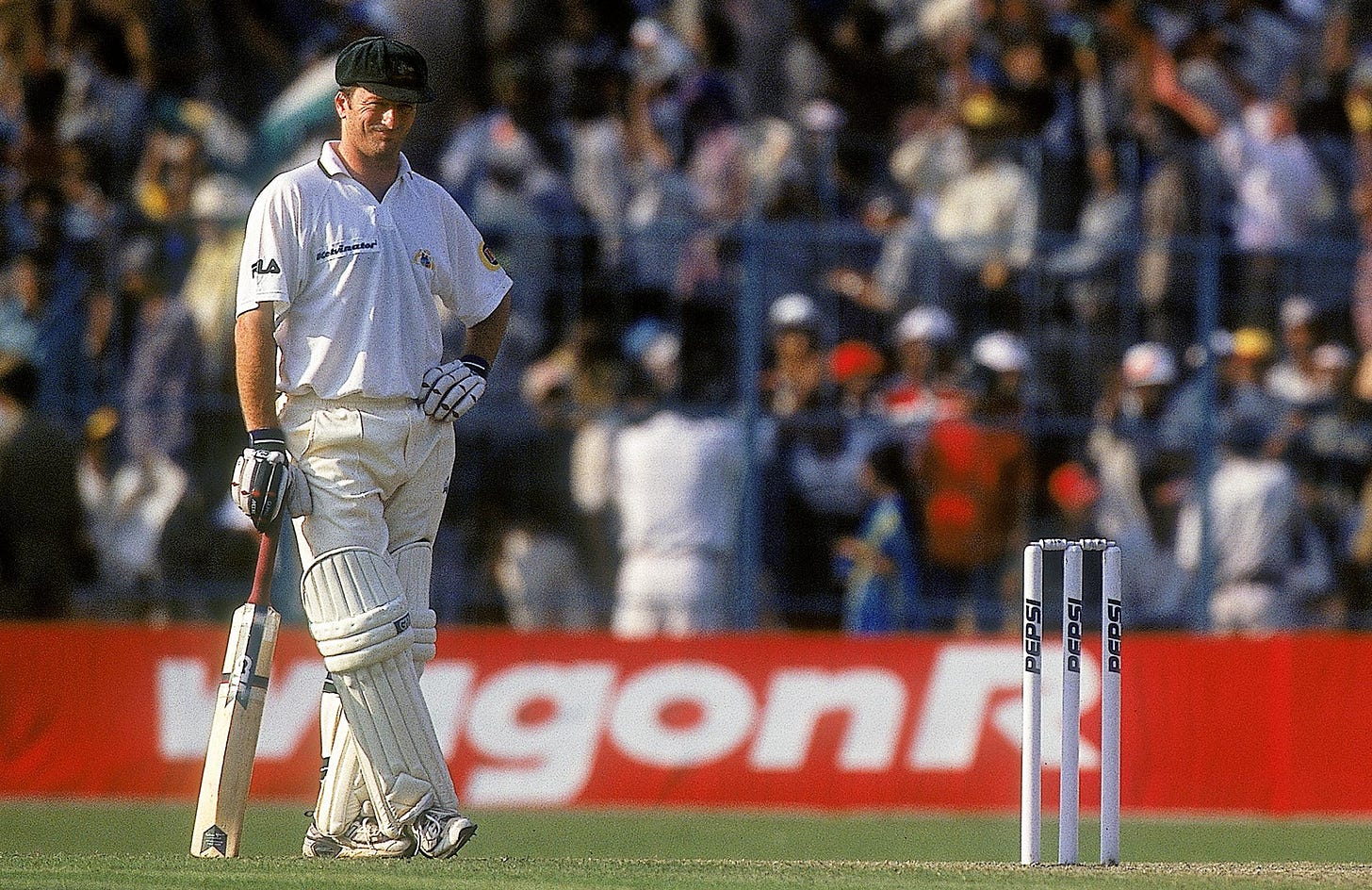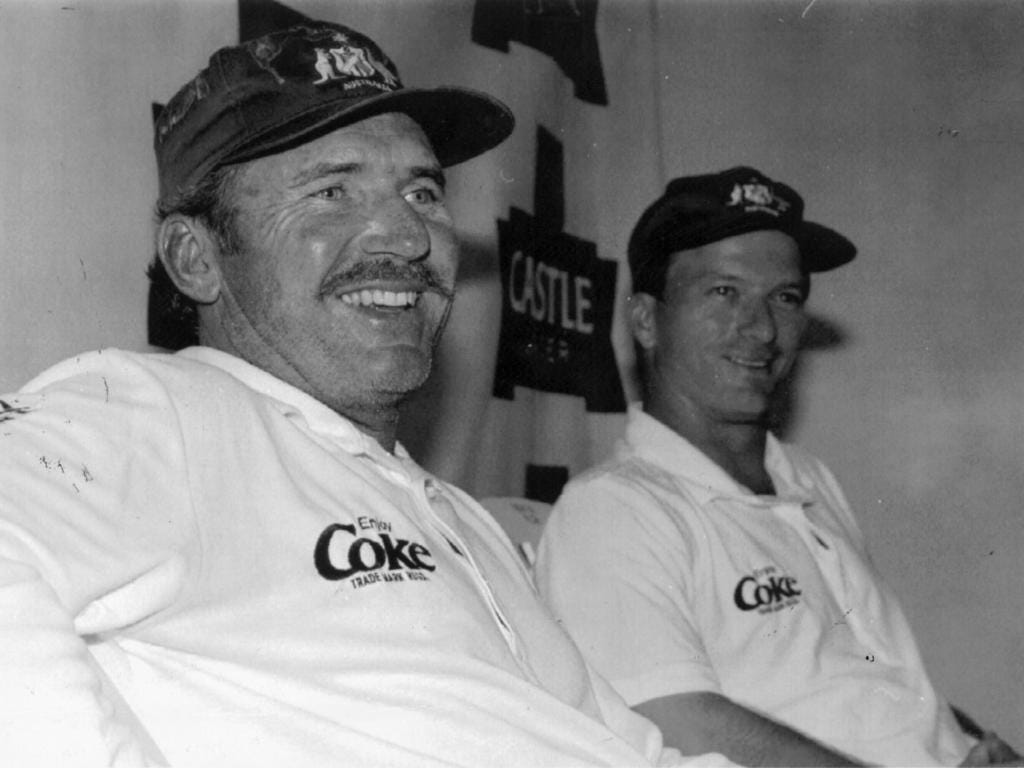Steve Waugh's 5 Lessons From Failure
(and applying it to investing)
With the Border-Gavaskar series starting up (which I’m extremely confident Australia will win1), I resonated with these lessons on failure from Steve Waugh within Bob Woolmer’s cricketing bible, Bob Woolmer's Art and Science of Cricket, and can’t see them anywhere else on the internet, so thought it would be worth sharing.
And more than anything, these lessons transcend cricket.
Whether it be investing, building a business, or trying to run a podcast, there are plenty of takeaways with a good story to boot.
Who the hell is Steve Waugh?
Even though Indians and Australians make up the bulk of my readers, I’ll provide a smidge of context to get my non-cricketing friends up to speed.
Steve Waugh is not only a former Australian cricketer, but is one of the most successful and respected captains in history. Known for his gritty determination and ability to perform in high-pressure situations, he was a bit before my time as a cricket tragic kid, but the stories around him were legendary.
Lessons from Failure
But in December 1996, Steve Waugh revealed to cricket writer Greg Bauer the psychological strategies he had used to turn personal failure into triumph.
After Waugh made a duck in the first innings of a Test against India in Delhi in October 19962, he went on to use all the errors he had made prior as the platform for his subsequent 67 not out (ground out over two days, and facing over 200 balls), no mean score on a traditionally tricky subcontinental wicket in the second innings.
After his first innings failure, Waugh listed all his mistakes that went into his duck.
The list was a catalogue of avoidable blunders: he had been watching the match on the television monitor, and had thus exaggerated to himself the dangers of the pitch (which was apparently in piss poor condition - umpire Peter Willey described it as the worst first-day pitch he'd encountered); he had been caught up in the noise and commotion of a dressing room full of visitors, instead of preparing mentally for what was to come; he had left behind the lucky red rag that he always liked to have in his pocket when batting; he had not formulated a strategy against India's spinners, who were making the most of a pitch that heavily favoured spin; and finally, he went out agitated, intimidated, and expecting to fail.
But rather than dreading his next innings, he put together a strategy for coping based on the advice of people he trusted and respected.
That night, he phoned two people: first, his former captain and teammate, Allan Border, to ask for technical advice; and second, his wife, knowing she would give him the personal support and affirmation he needed.
Waugh paid special attention to the following Indian innings, carefully observing how their successful batsmen managed to deal with the pitch without losing their wickets.
He gave himself a pep talk about over-reliance on his lucky red rag, telling himself, “If I've got it, it's nice to have it here. But it's not going to play my shots for me!“
On the day of his second innings, Waugh withdrew into a corner of the dressing room, studied the field while perfecting the details of his plans for the bowlers, and gave himself plenty of time and space to prepare for his turn at the crease.
A vital part of Waugh's approach was not to allow the prospect of facing any bowler to intimidate him. According to Bauer, Waugh said of Kumble, “He's probably the best spinner in the world on that type of wicket and yet it was almost as if I wanted to get down [to) his end and face him!”
Waugh had a strategy for playing him all figured out, and was prepared to play a waiting game until he saw an opportunity to score. Waugh has described this as the most satisfying aspect of Test cricket: facing a really good bowler and taking the game to him.
These realisations from Waugh might not be particularly ground-breaking I hear you say.
But in each of these lay the kernel of larger lessons, which Waugh was experienced enough to recognize, and adapt to his situation.
These lessons are worth learning, and apply to many fields, not just cricket.
LESSON #1: NEVER BE TOO PROUD TO ASK FOR HELP.
Don't be afraid to look outside your own camp for help. Waugh found some useful ideas for playing leg-spinner Anil Kumble from an article in which South African captain Hansie Cronje described his team's strategy for playing Kumble's unique brand of fast, bouncy and barely deviating spin. It is also worth noting that a quiet chat with a supportive non-cricketing friend or relative - someone who believes in you, knows your strengths and can affirm them - can be a great psychological boost, even if they don't understand much about the cricket skills involved.
Reaching out for help or even just having a supportive chat is also extremely relevant to investing, which can be a brutal and lonely field.
Don’t get stuck in the bubble.
Branch out, learn from others. Which leads to the next lesson…
LESSON #2: DON'T UNDERESTIMATE THE BENEFITS OF LEARNING FROM THE OTHER SIDE DURING THEIR INNINGS.
Waugh's careful observation of how the Indians were coping with the conditions paid dividends. All too often, when the opposing batsmen are getting on top of the situation, we see the fielding side's heads going down. They might be better occupied observing what it is that the successful batsmen are doing right, and planning their next innings accordingly.
Charlie Munger (and many other famous and successful investors) often preach the value of learning new disciplines and educating yourself outside your area of expertise.
It is critical for a person who desires to be wise to think broadly and learn from others. Munger has said many times that someone who is really smart but has devoted all of their time to being an expert in a narrow area may be dangerous to themselves and others.
Examples of this include macroeconomists who study the economy but are disastrous when investing their own portfolios and marketing experts who may think that most all business problems can be solved through marketing. Financiers tend to think similarly about their own profession. Too many people believe that what they do at work is hard and what others do is easy.
“It is better to be worldly wise than to spend lots of time working with a single model that is precisely wrong”
LESSON #3: USE GOOD-LUCK CHARMS AND PERSONAL RITUALS TO BRING YOURSELF UP, NOT DOWN.
An astonishing number of top cricketers are superstitious and cling to certain rituals before or during a match. During India's 1996/97 tour of South Africa, Sachin Tendulkar insisted on wearing a special set of pads, once owned by Sunil Gavaskar, regardless of their increasingly battered appearance. Viv Richards always insisted on leaving the dressing room and taking the field last when his side was fielding. Shane Warne believed that his lucky number was 23, and was greatly heartened at the least sign of it (such as on his hotel room door).
The psychological benefit of lucky charms and special rituals can be great if they boost the confidence and comfort the player (or, as an added bonus, rattle the opposition); but their absence should not be allowed to make any difference.
Maybe this one is more cricket focused, but here’s my take.
For a while there, I poo-pooed anyone with superstitions in sports, putting them in a similar bucket to people who believe in star signs. As if my crusty red jocks with holes in them actually improve my batting? But eventually, I realised that if they do help me get in a comfortable state of mind, they can be helpful, even if not directly helping me physically as a batter.
So nowadays, if one of my missus mates starts rambling on about how Venus and Jupiter are aligned perpendicular and have gone into retrograde so that means they’re going to have a good 2023, so be it. I’ll bite my tongue as best I can, let them live their life (it doesn’t affect me, so why should I stress?), and hell, who knows maybe they might have a good 2023 because they thought good juju they thought was coming.
LESSON #4: FIND OUT WHAT WORKS FOR YOU IN THE DRESSING ROOM. THEN STICK TO IT.
Waugh had played enough cricket to know what worked for him, and by withdrawing into a corner to plan his strategies, he was retreating into a familiar and effective working space. Don't allow distractions if you know you need quiet. Don't brood if it makes you tense. If you know that you have done everything possible to prepare and you find that studying the game is making you more, not less nervous, then find something absorbing to do.
It took me a while to figure this out on my own, but some people just suit different styles of investing.
Don’t force something you’re not. If you enjoy being plugged into markets 24/7, are wildly emotional, and change your mind constantly, maybe value investing isn’t for you? Find a different approach that works for you.
Plenty of ways to skin a cat.
LESSON #5: RELISH THE CHALLENGE OF FACING A CLASS BOWLER.
No player should walk out to face a bowler without a strategy for playing him. And this means that the bowler is not testing you; you are testing yourself against that bowler. The distinction is a fine, but vital one. It means that in the final analysis, it is not the individual bowler that is causing the problem, but your approach to him.
This is closely related to perhaps the greatest hurdle of all: batsmen who put themselves under pressure. If they walk out to the crease intimidated by the way the game is going, the pitch, the bowler, and above all, believing that they will fail, they don't stand a chance.
Waugh freely admits that he got himself out in the first innings against India because he put pressure on himself and went out expecting to fail. When preparing his gear for the second innings, however, he packed enough changes of clothing to last right through a day of batting - a symbolic way of indicating to himself that he believed that he would not go out, and would bat right through the innings.
This is such a banger to finish with. Replace ‘bowler’ with ‘the market’
You might be able to sum this whole point up even further with the 5 P’s.
Prior Preparation Prevents Piss Poor Performance
When things go wrong, one option is the grin and bear it. But don’t discount the idea of stepping back, reevaluating, and getting stuck back in.
I’ll finish with one of my favourite quotes from one of my favourite blokes, Lee Kuan Yew:
I believe that life is a process of continuous change and a constant struggle to make that change one for the better.













Loved this post!! Thanks for sharing. The last one was really a banger.